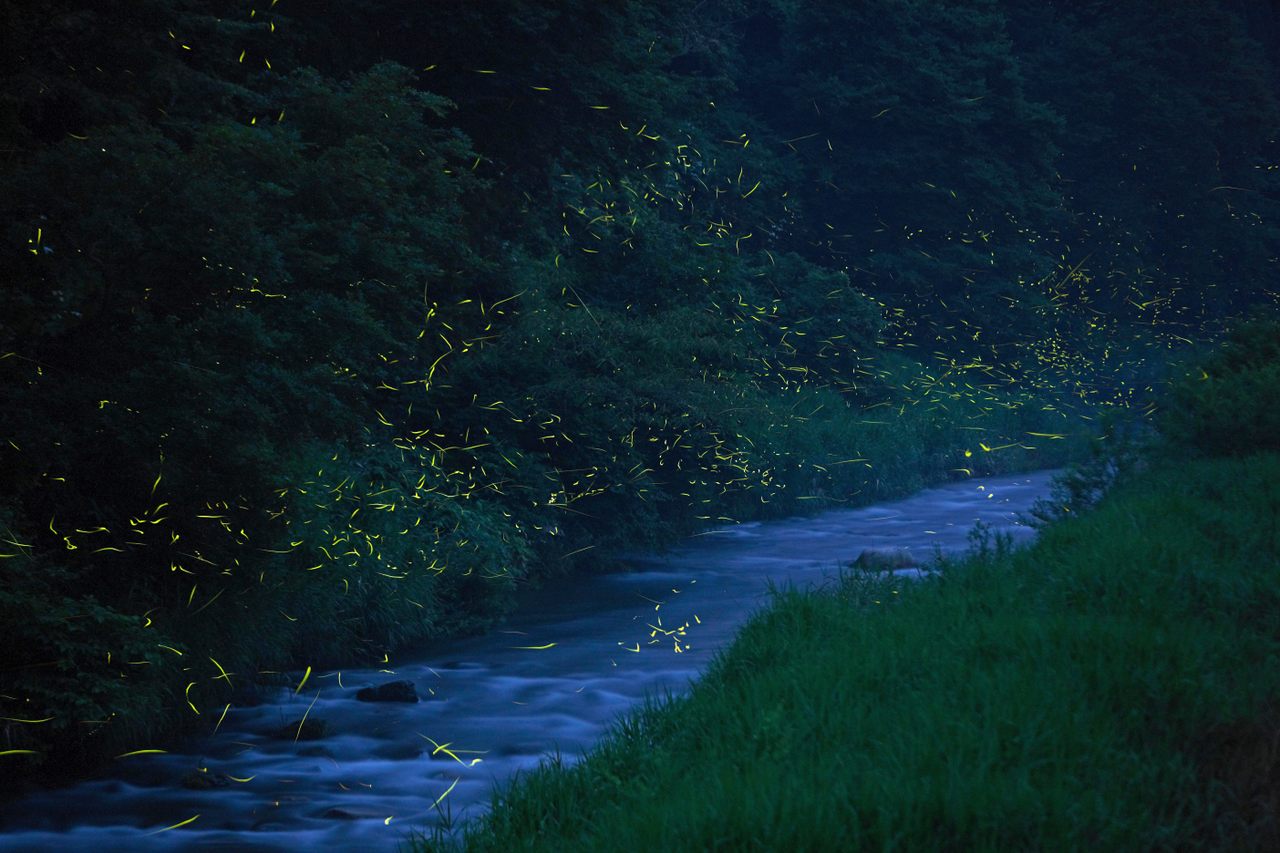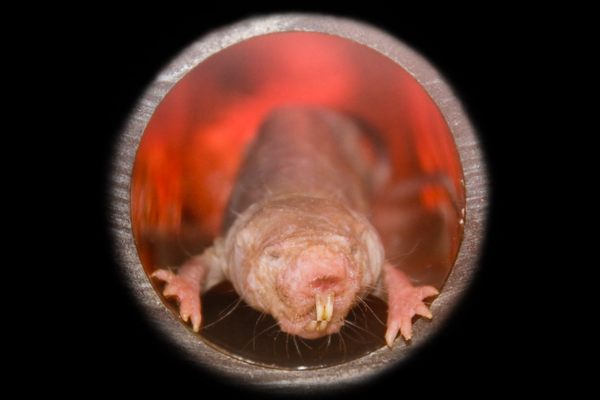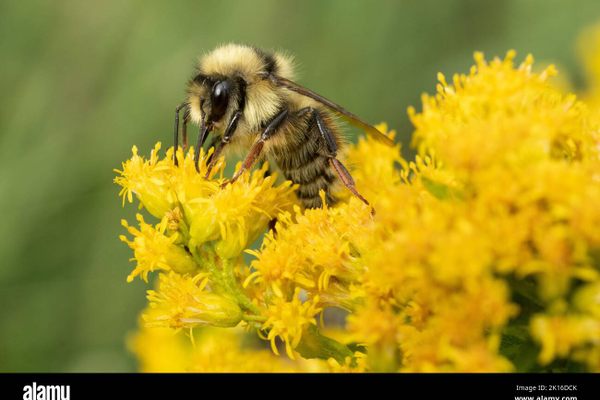How A ‘Firefly Course’ Is Saving Japan’s Favorite Glowing Insect
At the Moriyama City Firefly Forest Museum, nurturing Genji fireflies comes with homework.
At the third meeting of the Moriyama City Firefly Forest Museum’s eight-week Firefly Course, a conservation training program for adults, egg collection begins. Each female Genji firefly, Nipponoluciola cruciata, can lay up to 500 of the caviar-like orbs, carefully depositing them across the mossy banks of rivers and streams in blankets of pale yellow.
In the wild, only a tiny fraction of the eggs survive. River pollution, flood prevention measures, overfishing, and excess urban light devastated the insect’s population in the 20th century. But at the museum, artificial breeding and rearing methods will coax 30,000 Genji fireflies into larvae, a phase in which they live like tiny, voracious underwater explorers.
Each month, the 10 students of the Firefly Course return to the museum to learn about the breeding and rearing techniques of the Genji and their primary food source, freshwater snails (Thiaridae). “Hundreds of thousands of water snails are required” to feed the larvae, explains Firefly Forest Museum director and Firefly Course teacher Michio Furukawa. Between birth and maturity, they’ll help the fireflies multiply up to 20 times, growing in length from the thickness of a grain of rice to the diameter of a penny.
By the students’ seventh meeting, about 5,000 of the hatchlings will have survived long enough to be released from their breeding tanks into the museum’s man-made river in February. Only the heartiest of the bunch will reach the final stage of adulthood, the one that glows.
Thirty years ago, when the Moriyama City Firefly Forest Museum first opened, the future looked dark for the revered Genji firefly, whose populations had barely begun to recover more than six decades after Japanese conservationists recognized that their lights were going out. It wasn’t always this way, especially in Moriyama, where swift rivers and pristine natural banks made for the ideal Genji habitat.

In Japan, fireflies have long been the harbingers of summer, taking to the skies in June and July in a flickering dance of courtship that lights up the night. Moriyama’s Genjis were especially prized for their vivid, yellow-green glow, drawing tourists from around the country by at least the mid-19th century.
But eventually, intrepid entrepreneurs realized that they could make more money by capturing and shipping the tiny insects from Moriyama to population centers like Osaka, Kyoto, and Tokyo than they could by waiting for urbanites to come to them. Throughout Japan’s Meiji period, which stretched from 1868 to 1912, a commercial firefly industry gorged on the colonies emerging from Moriyama’s waterways.
In just one night, a single firefly hunter could capture as many as 3,000 of their prey, scraping the earth with bamboo brushes to frighten just-mated, egg-laying Genji from the riverbanks. The next morning, the insects were carefully packaged and shipped off to form the luminous blinking decor at shi-shi hotels, restaurants, and private gardens. For years, it was Moriyama’s fireflies that had the honor of being presented to Emperor Meiji as a precious gift which, in Japanese culture, symbolizes passion and the fleeting impermanence of all living things.
“Harvesting fireflies was big business,” says Tufts University biologist and firefly researcher Sara Lewis, author of Silent Sparks: The Wonderous World of Fireflies. It was also a death sentence, not just for those fireflies who, when released in cities or kept in lanterns or cages there, had no appropriate habitat to lay eggs or grow into larvae, but for the firefly ecosystem back home. Because it was easiest to capture female Genji as they laid their eggs on the mossy riverbank, she explains, there were fewer and fewer left to produce the next generation.

Meanwhile, a fast-urbanizing Japan was turning Moriyama’s once ideal Genji habitat into a toxic, pesticide-spiked morass in which few fireflies could survive. Concrete was laid on the banks where there was once moss to protect their eggs, wastewater and industrial runoff seeped into the clear waters where the larvae grew, overfishing disturbed the juvenile insects and their snail food source. More than a century later, Moriyama’s firefly population has rebounded only slightly from its near extinction in the first half of the 20th century.
When it was established in 1990, the Firefly Forest Museum’s founders set its rustic, wood-clad institution in the kind of habitat Genjis would find irresistible. They dug a fast-moving artificial stream and planted its banks with soft, protective moss. They brought in trees from the nearby Yasu River, planting them in a shady grove without lights that might confuse the amorous bugs during mating season.
Inside the museum, they mated and bred the Genjis; it is still the only public institution to do so on a large scale, according to Furakawa. Today, the process begins in the fall with moss-layered trays in which flashing male and female fireflies—a signal of their sexual receptivity—generate thousands of fertilized eggs. When they hatch, the larvae are transferred from the moss to tanks filled with artificially flowing spring water. They grow there in a gluttonous orgy of snail consumption until February, when the larvae are hearty enough to move to the manmade firefly river, joining their naturally bred cousins for the remaining months of snail noshing. Then, together the fireflies leave the water and take flight beginning in June.
The science is sound but, despite their efforts, “the number of Genji fireflies has not increased so much [in the region],” says Furukawa. “Habitats continue to decrease due to urbanization, and Moriyama City is constantly debating what to do in the future.” Unless they preserve existing habitat and create new spaces for the insects, fireflies will continue to suffer.

No matter how many fireflies the museum and its acolytes are able to produce in the artificial firefly forest, those that survive into the next generation have no need to move beyond the optimized habitat into dirtier, more urbanized natural environments. That’s a major problem for actually restoring their populations. “Sometimes people try to increase only the fireflies and forget to conserve the whole habitat,” says Yuichi Oba, an environmental biologist who studies fireflies at Chubu University in Kasugai, Japan. “They [can] release the cultured larvae to the river but if the river is still dirty, of course, the larvae cannot survive.”
That’s where the museum’s educational objectives come in. Throughout the year, Furukawa lectures on the revered insect’s history and ecology in elementary and high schools. They also lead museum activities, such as the eight-week Firefly Course for adults, and other training and awareness campaigns, including the museum’s magazine, From the Firefly Forest.
Though they’ve been slow to pan out, similar efforts elsewhere, including at the Okazaki City Firefly School, which, in addition to educating local children and families, organizes community cleanup efforts in and around the Otogawa River, may make a difference in the long run, explains Dai-ichiro Kato, a firefly researcher at Kagoshima University in Kagoshima, Japan. “I believe that if the general public becomes more interested in and engages in conservation activities nationwide [over the next 10 to 20 years], the local environment will be restored little by little and may contribute to the long-term recovery of the firefly population.”
But the only chance at returning Genji firefly populations to their pre-industrial numbers is to act now. Kato warns, “We are running out of time to provide [the necessary] environmental education” to save Japan’s beloved glowing insect.




















Follow us on Twitter to get the latest on the world's hidden wonders.
Like us on Facebook to get the latest on the world's hidden wonders.
Follow us on Twitter Like us on Facebook